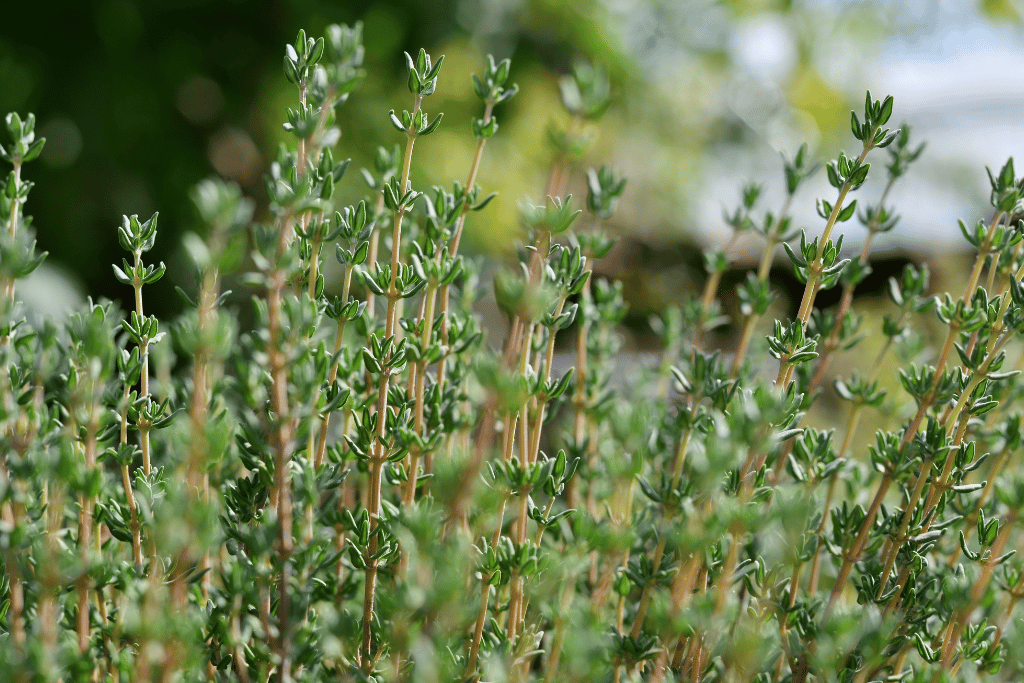Fiddle leaf figs (Ficus lyrata) are one of the most popular houseplants, donning large and glossy leaves which implement a sense of nature into any space. Though, they are susceptible to a lot of the common problems that other plants run into. Various different diseases and pests can cause damage to their leaves, such as brown spots, but other factors, such as overwatering, underwatering and temperature fluctuations, can also cause this too. It’s essential to identify why your fiddle leaf fig is developing brown spots and how best to stop this.

In this article, I’ll discuss how the different factors listed above and others, such as pests, disease and inadequate lighting, can cause brown spots on the leaves of fiddle leaf figs. I’ll explain each of these factors in detail, telling you how you can prevent this from happening and taking steps to ensure the plant becomes healthy again.
Overwatering
Let’s start off with one of the most apparent and common factors that could cause brown spots on a fiddle leaf fig. When a plant is overwatered, the soil can become waterlogged, leading the roots to become oxygen-deprived, promoting root rot. Root rot can cause brown spots to start to appear on the leaves, which can cause yellowing, drooping and wilting of the leaves.
To make sure that we don’t overwater our plants, you should only be watering when your plant needs it. I like to feel the top inch of the soil, making sure that it has adequately dried out before watering the plant. If the soil’s still moist or soggy, then it’s best to hold off on watering until it dries out slightly. When watering, make sure that you water thoroughly and allow any excess water to drain away from the pot, making sure that it doesn’t stay in there. Leaving plants in standing water can contribute to root rot and the growth of other harmful pathogens.
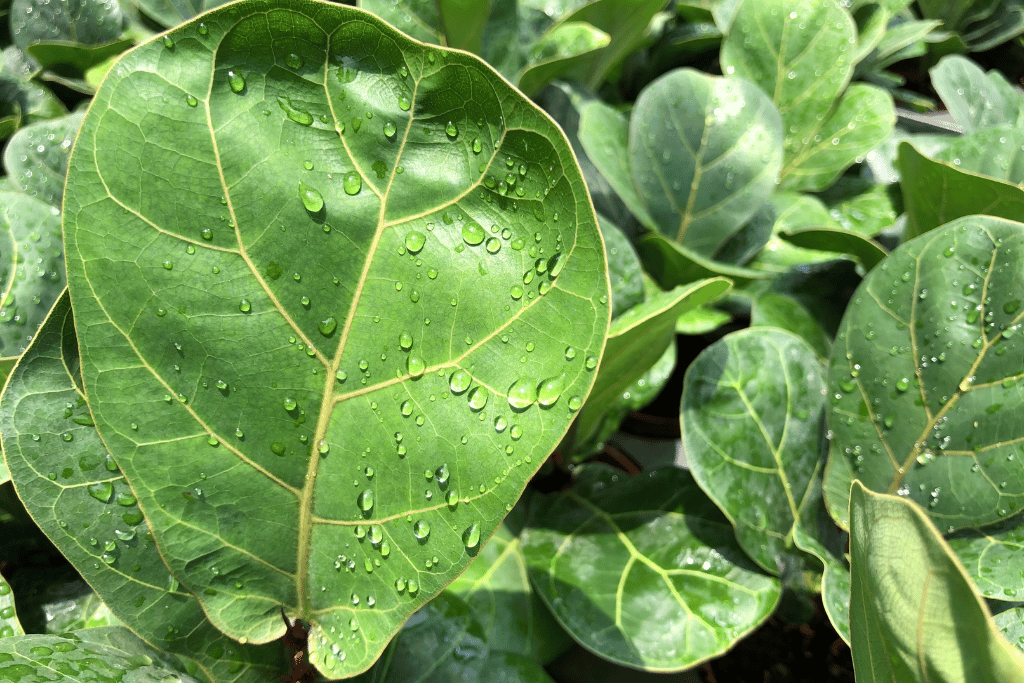
Nursing an overwatered plant back to health is simple as long as it hasn’t got too severe. You can simply return to a normal watering regime, only watering the plant when the soil has dried out enough. It’s important to note that if you have overwatered your plant, you shouldn’t let it dry out completely, as this will kill it just as fast. If the overwatering has got quite severe, you may have to repot the plant in fresh and well-draining soil, trimming any dead or damaged roots.
I’m not particularly eager to water on a schedule, mainly because of this. Watering on a schedule can promote overwatering or underwatering, as plants will have different water demands at other times of the year. In summer, their water demand will significantly increase as they put out more growth, so it’s important to adjust accordingly. I typically only water my plants once a week or longer in winter, depending on the species.
Underwatering
The opposite of overwatering – underwatering. It’s hard to strike a balance, isn’t it? Plants can be finicky, but over time and with experience, you’ll start to get the hang of it. Underwatering is a common cause of brown spots on pretty much every plant, as well as fiddle leaf figs. When a plant is underwatered, the leaves will start to become dry and crispy, browning around the edges. You’ll notice that the brown spots may be much more concentrated around the edges of the leaves.
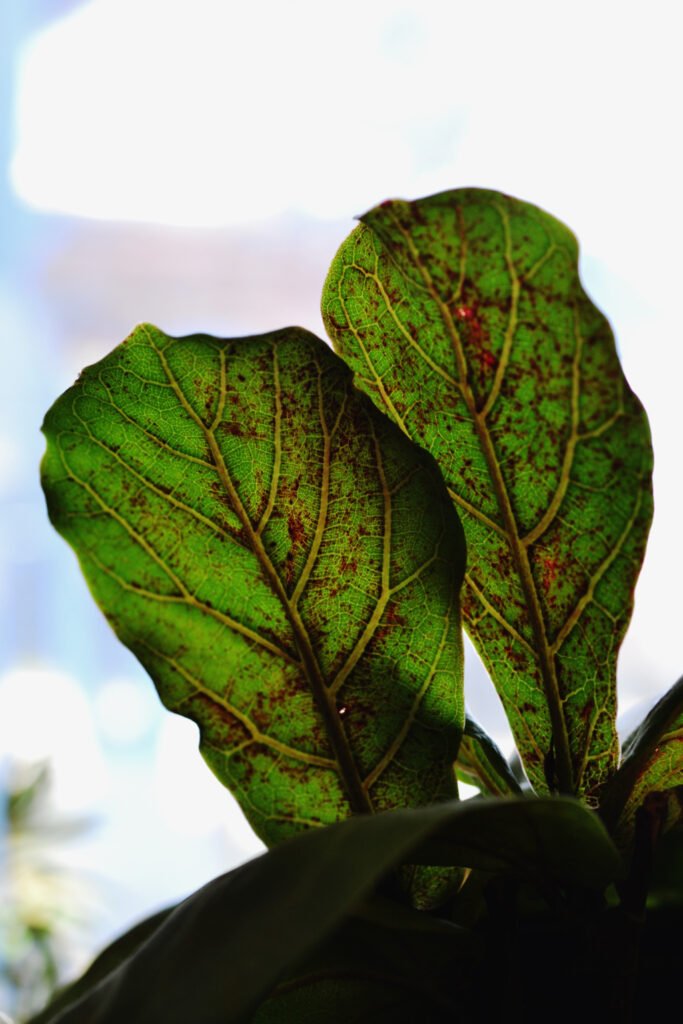
Preventing underwatering is essential. Make sure to water your fiddle leaf fig regularly and thoroughly – many people only give them a few drops of water, but they should be soaked. As I’ve mentioned above, you should wait until the top inch of the soil starts to feel dry to the touch before watering – making sure that the soil does not completely dry out.
If you believe that your fiddle leaf fig has already started to suffer from underwatering, it’s best to increase how frequently you water it. Ensure that you soak the plant’s soil when you water, ensuring that the roots are receiving enough water. It might help to mist the leaves regularly, increasing the humidity and preventing further water loss from the plant.
Insufficient Lighting
Light is what allows plants to grow, and without it, the vast majority of them would be dead. In particular, fiddle leaf figs need to receive bright and indirect light to thrive. If your plants aren’t receiving enough light, you’ll notice that the leaves will start to develop brown spots and become pale and yellowish. You may see that the brown spots will develop on any part of the leaf, not just the edges.
Making sure your plants have adequate lighting is essential. Your fiddle leaf fig should be placed near a window that receives bright and indirect light, with at least a few hours of light per day. If you can’t give it this, you can supplement it with a grow light – though this may not be an option for a space such as an office.
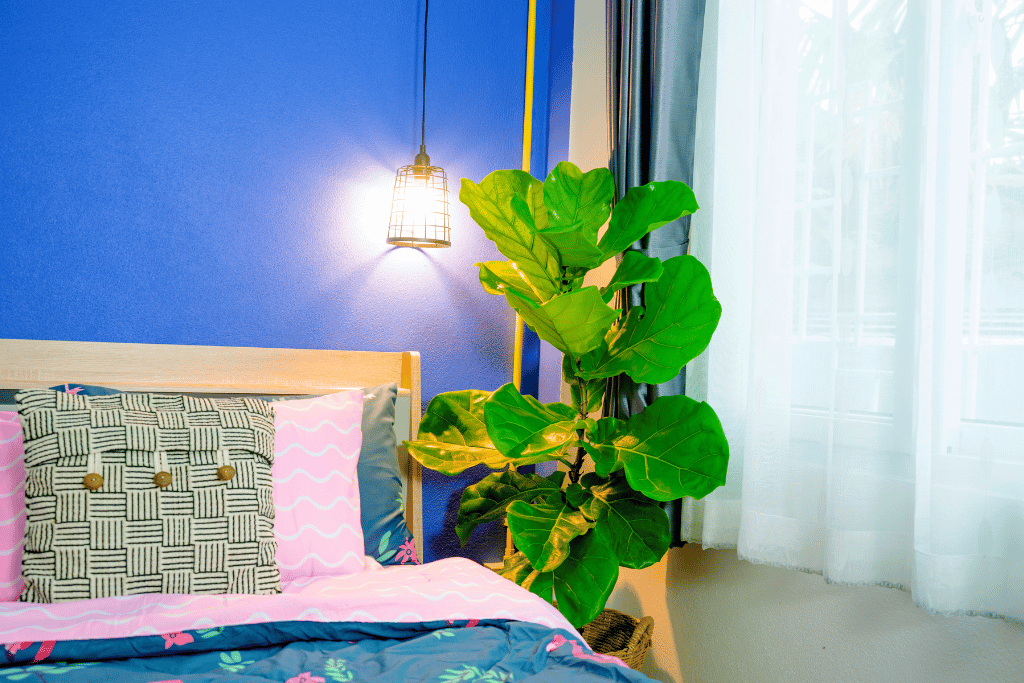
Suppose you think that your fiddle leaf fig has already started to suffer from inadequate lighting. In that case, it’s important to move it to a brighter location as soon as possible, pruning any damaged or dead leaves to help the plant get rid of them and stop any spread of pathogens. Make sure that it isn’t in direct light, though, as the leaves could get sunburnt, which could lead to the plant being worse for wear.
Large Temperature Changes
As fiddle leaf figs like to be kept on the warmer side with a bit of humidity, this makes them quite sensitive to temperature fluctuations. When they are exposed to cold drafts from large windows or doors constantly or hot and dry air, the leaves may start to brown.
Preventing temperature fluctuations will help to keep your fiddle leaf fig healthy. Make sure that they are kept away from windows, doors and particularly air conditioning vents. Temperatures of around 15-23C (60-75F) should be maintained, with high levels of humidity too. To increase the humidity, you can mist the leaves regularly and use a drip tray or a humidifier. A humidifier is probably for the more hardcore growers but could be a worthwhile investment if you like your houseplants.
If you think that your fiddle leaf fig has been exposed to a lot of temperature fluctuation, it’s best to move it to somewhere with a stable temperature, misting the leaves to increase the humidity. Make sure that the new location gets bright and indirect light, with at least a few hours of light per day. You don’t want to kill the plant by moving it to somewhere too dark!
Pests
Many plants are susceptible to many different pests, and I can’t express how many times I’ve found infestations, even though I swear I checked the plant the day before. Fiddle leaf figs, in particular, are vulnerable to pests such as scale insects, mealybugs and spider mites – which will suck the sap from the leaves. This can cause them to turn brown or yellow, developing spots. Depending on the pest, they may also leave a sticky residue, such as honeydew or webbing on the leaves.
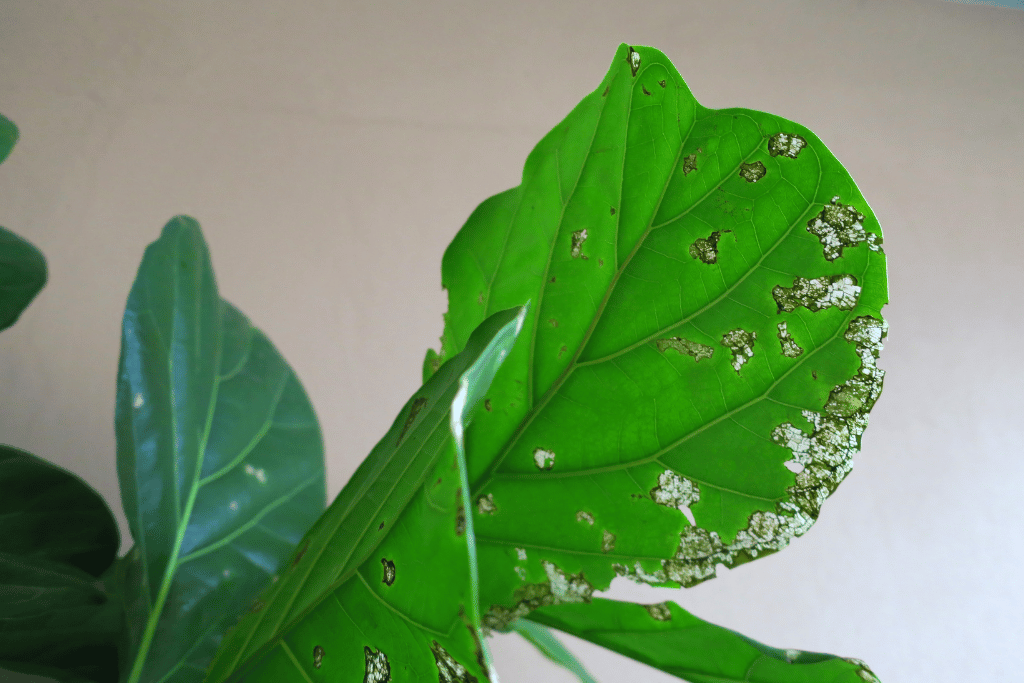
Preventing pests should first begin with regular checking of your plants. I always give my plants a thorough check at least once a week, ensuring no problem signs developing or explicit pests that stand out. Any plants that you do notice with pests should be isolated from the others, helping to prevent the spread of the infestation. Make sure to sterilize any pruners and wash your hands if you have been working on said plant.
If your fiddle leaf fig is currently dealing with a pest infestation, you’ll have to help it along with something like an insecticide. Any heavily damaged stems or leaves should be pruned away. In terms of insecticide, I prefer something natural but effective such as neem oil – but you can get other insecticides which might be more effective. Just beware that these may harm other useful insects, though!
Diseases
Pests and disease like to come as a cute little package of misery – but disease is the one I worry about a lot more. Fiddle leaf figs can be susceptible to many different diseases, such as fungal infections (powdery mildew), root rot and leaf spot. This can cause brown spots on the leaves, leaf drop, wilting and yellowing.
Discuss more in detail: Why is my fiddle leaf fig drooping?

To prevent disease, make sure that you isolate any plants that are currently affected. Any tools you’ve used to work on those plants should be sterilized, and you should wash your hands if you have touched the affected plant. Make sure that you don’t overwater your plants, and keep them in a well-ventilated location. This will help to prevent fungal infections from developing. I always like to keep fungicides on hand – powdery mildew always seems to get you when you least expect it!
If your fiddle leaf fig has already suffered from a disease, you might need to prune any of the infected leaves and stems, treating the plant with a fungicide to make sure that the infection is stopped and prevented.
Final Thoughts
Identifying the cause of brown spots on fiddle leaf figs essentially translates to any other species of plant too. The factors listed above are almost always one of the reasons your plant is developing brown spots – underwatering or overwatering is definitely the most common (especially for new gardeners). So, in general, the best way to prevent and treat brown spots is to maintain a good watering habit for your plants, give them a good amount of humidity and light, and protect them from temperature fluctuations, pests and disease. A well-looked-after fiddle leaf fig will thrive and look beautiful for years.
Frequently Asked Questions (FAQ)
How many times a week should I water my fiddle leaf?
Though I said not to stick to a particular schedule to water your plants, you’ll probably water your fiddle leaf fig around once a week. Make sure that you’re monitoring the moisture of the soil before you water, though, as you don’t want to promote overwatering or underwatering. Plants that are kept in a minimal amount of light are a lot less likely to dry out quickly, so if you find that the soil is drying out extremely slowly, it may need more light.
Can I water my fiddle leaf fig with tap water?
Yes, you are able to use tap water when watering your fiddle leaf fig. Some other species, like Dracaenas, are sensitive to the fluoride and other chemicals typically found in tap water, but fiddle leaf figs are entirely safe to water with tap water. If you’re still unsure, though, you can collect rainwater to use. I only do this with lime-hating species, such as azaleas.
How do I know if my fiddle leaf fig has root rot?
If you’re worried that your fiddle leaf has root rot, there are a few common signs you can look out for. Root rot is typically caused by overwatering or excess water left over in the pot in which the roots are sitting. Signs of root rot include; wet, soggy or mushy brown roots, waterlogged soil/roots and a foul smell coming from the roots. Mushy brown roots are usually the most common sign I notice – but don’t be afraid to sniff that soil (maybe without other people around?), as you’re likely to pick up on a bad smell.
When should I repot my fiddle leaf fig?
Typically, fiddle leaf figs can do with a repot around every two years. This is normally done in spring, as the warming weather conditions will help your plant recover from root shock. Potting the plant in a large pot may mean you can do this every three to four years, but I like keeping the soil fresh.



